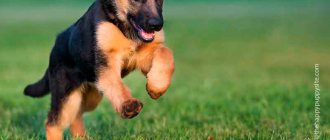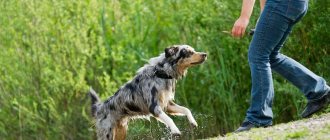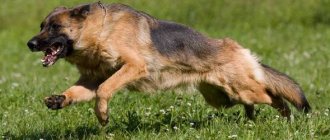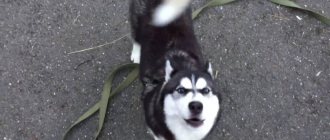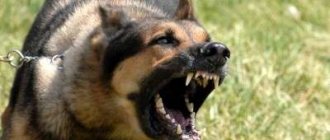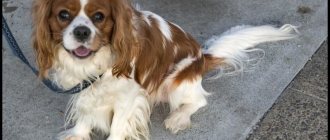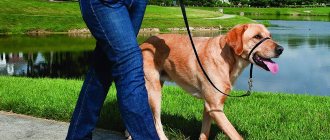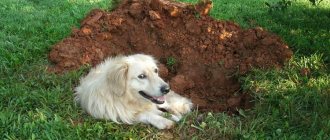Why do you need to teach your dog the “face” command?
The “fas” command is used for self-defense in the event of an attack on the owner by an attacker. If the dog is trained to attack on command, his actions in the future can save your life or at least preserve your health.
Also, in the event of theft, with the command “front” the dog will be able to catch up and detain the criminal until you arrive.
Service animals are taught this exercise from childhood, but this skill is also quite learned by pets. The main thing is to approach the training of the animal responsibly, taking into account all the small details.
Preparing a dog to learn the “Fast” command
Dogs come in different breeds:
- fighting;
- sentinels;
- decorative;
And their purpose is different. Therefore, the approach to their training is absolutely individual.
It is necessary to take into account that animals have certain instinctive patterns of behavior at the genetic level. For example, a shepherd dog will accept the “front” command much faster and with greater pleasure than a poodle or terrier.
The front command for a dog is quite serious, one might say even aggressive to some extent. It means an attack on the enemy in order to protect the owner. Naturally, this is not the command you should start training your pet with. It is necessary to firmly understand that in order for an animal to develop such traits as anger and distrust, long and systematic training of the animal is required.
Firstly, the dog must know, understand, listen and hear its owner well. This is one of the main conditions. Otherwise, what kind of study can there be? The commands “”, “guard”, “give”, “near”, “sit” the pet must know and carry out at the very first word of the owner.
Secondly, you need a suitable place to conduct classes. This place may be familiar to your pet or even loved by him. At the same time, you should take into account that there is nothing distracting during training: no extraneous noise, no people, no unfamiliar objects.
Another necessary condition: you will need an assistant, without whom it is impossible to conduct classes with your pet to teach this command. It is necessary to provide reliable cover for the assistant. Training is impossible without a special suit. It must be durable, strong, and thick enough. It is necessary to provide a place where the dog can be fastened on a leash.
Features of training
- Before you start training your pet as a serious command, you need to realize whether you are ready to take on such responsibility, because if you make mistakes in training, it will be difficult to avoid irreversible consequences.
- To avoid the risk of aggression in an animal towards people or animals in everyday life, it is recommended to periodically visit a dog handler so that he, seeing the shortcomings in reality, can help you correct them. If the dog trainer sees that you are training your pet incorrectly, he will direct you in the right direction.
- Not all dogs are capable of learning the “face” command. Training depends not only on the breed of the animal, but also on its psyche and character. You cannot teach the “face” command to a dog with a weak nervous system (such dogs are cowardly and overly emotional). It is strictly recommended to train an aggressive animal with the help of an experienced dog handler, since you yourself can only aggravate the situation.
- Before learning the “Face” command, the dog must know the basics of the general training course. The main thing is that the dog respects the owner and does not violate boundaries, and also clearly understands the meaning of the “fu” and “no” commands.
- It is impossible to learn the "fas" command alone. You will need an assistant in a specialized protective suit.
- In addition to training, do physical training with your pet. Build strength and endurance in your animal, develop muscles. At a minimum, you should take your dog for long, active walks. You can also give your pet trotting and swimming exercises to improve physical fitness.
It is important not to overdo it and adequately dose the load for the animal. Of course, the dog must be healthy.
Conditions for taking the ZKS course
It is not recommended to teach your dog the “Fast” command at home. To practice, you will need a “victim” - a person unfamiliar to the pet. That is, either you “exploit” comrades unfamiliar to the dog, or turn to a professional. Let us note that high-quality training, which will not bring you problems in the future, is carried out only under the supervision of a dog handler.
Let’s be clear right away that no sane and responsible trainer will undertake to conduct a ZKS course for a “disobedient” pet. A dog can take part in “aggressive activities”, provided that it already clearly, without a leash or physical influence, carries out the following commands:
- Ugh;
- To me;
- Near;
- Sit;
- Lie;
- Place;
- Voice is optional for the general training course.
In addition, the pet must clearly distinguish conflict situations from playful or spontaneous ones, otherwise the acquaintance who patted you on the shoulder may become an “enemy.” Before thinking about a course of ZKS, consult a dog trainer; in fact, there is a wide range of restrictions, which are primarily associated with the risk of developing uncontrolled aggression.
Note! Most often, there is an age limit in ZKS groups!
Where to begin
First of all, think about whether your four-legged dog will be able to learn the “face” command. If you have a gentle and soft pet that does not hold any pressure and, if something happens, can get scared and squeeze, it is unlikely that he will be able to really protect you in a moment of danger.
The “Face” command should be taught to dogs with a strong, stable psyche.
Find an open area with a tree or pole to which you can tie your pet. Under no circumstances should the dog be wearing a collar, as during the training process the animal will strongly pull and tear. To keep your pet healthy, wear a harness while training.
Features of breeds
For shepherds, following protective commands is common. These skills are inherent in them at the genetic level; they only need to develop and consolidate their abilities.
Dogs not intended for protection (decorative, small) can also learn to protect their owner, but they do not need this skill.
Tame dogs are easily excitable, cowardly, and training the “face” command develops uncontrollable aggression in them.
For hunting breeds, there are other types of training aimed at pursuing and capturing game. When starting to train a dog, it is important to consider the breed and its purpose .
Stages of training
Puppy training
You can start laying the foundation for a puppy from the age of 1.5-2 months. Of course, there can be no talk of any manifestation of aggression, much less an attack.
At this age, it is necessary to work with the puppy to strengthen the prey instinct. To do this, you need to take a toy and act out your pet.
Play a little every day, ending at the most interesting moment of the game. The dog must chase and pull the toy.
It is important to let the dog win in the fight so that he does not lose interest in the activity.
Offer your animal a variety of toys, including all sorts of rags, grips, and whatever your imagination allows.
The pet's grip should be strong enough, that is, he should hold the toy tightly and not intercept it while tugging. To strengthen your grip, make your dog feel more confident by allowing him to win more, and also develop an interest in the game.
It is important to teach the animal the skills of “give” and “fu” - the dog must unquestioningly follow these commands. By the time you reach one year, you can move on to the next stage of training, which involves training an adult animal.
Training an adult dog
Let the dog get acquainted with the territory of the lesson, then take the animal on a leash and tie it to a tree. Make sure your pet is not confused or distracted by anything.
Stand to the side of the animal so that its body is near your left leg. The dog must sit or stand.
Call the assistant - the person involved. Start saying “stranger” in a provocative tone. Even if the dog doesn’t yet know the meaning of the word, this is necessary to create an association with the “fas” command in the future. The word “stranger” will be a signal for the dog to follow the command “front”.
Ask your assistant to move in strange, hesitant movements. The person involved should also take a rag and wave it, moving towards the pet. A tight leash will further provoke the dog to show aggression. If you feel that the dog is tense enough, and the helper has approached close enough, make a sharp lunge forward and give the command “front”. The dog should rush towards the person and tear the rag or protective sleeve. Praise your dog verbally. After a few seconds, command “fu” and take the dog back to the tree. Repeat this several times.
Untie your dog from the tree, but do not let him off the leash. The animal should be near your left leg. Ask your assistant to move 3-5 meters away from you, also moving in a strange way. As soon as the dog tenses up, make a sharp lunge forward, giving the command “front”. The dog must run to the person involved and grab him. After a few seconds, give the command “fu” and take the animal away. Repeat this several times.
Ask the person involved to run away from the dog, and after placing the dog at your left leg, at the moment of tension, lunge forward and give the command “front”. The dog must catch up with the person involved and grab him, after which you come up and give the command “fu”.
Once you are convinced that the dog clearly releases the helper on the “fu” command, you can work without a leash. Train in different environments and under unforeseen circumstances, bringing the situation as close as possible to the real one. Only then will the pet really be able to protect you in the event of a real danger.
Teaching a puppy the “Fast” command
The pet must be tied so that it cannot break away. Remember that you need a very long leash so that he can move freely. The trainer stands next to the animal.
The assistant slowly moves forward and teases with a stick or other object, makes noise, screams (a familiar toy is not used). As soon as the stick becomes interesting to your pet, he focuses his gaze on it, say: “fas.” If after these words the dog becomes aggressive, tries to rush at the assistant, growls, barks, then it needs to be encouraged: petted, praised (just do not feed it).
Next, the assistant begins to beat the dog with a stick, but not too painfully, otherwise it will get scared and the desired result will not be achieved. As soon as the animal begins to bite the stick, it should be offered a rag in return. After the dog grabs the rag, the assistant tries to take it away from the dog. In this manner, a struggle for a rag begins, as it were.
As a result, the rag should remain with the dog, and the person, demonstrating fear of it, runs away. The pet is rewarded with praise and petting. During this fuss, the “fu” command is heard several times in a loud voice, with a firm intonation. This training is carried out several times.
Training recommendations
The pet should not see how the trainer and assistant communicate with each other. If the dog sees that the owner and his accomplice are communicating nicely, then during training he will become confused and will not be able to accurately follow the command. A complete stranger, a person unfamiliar to the dog, is invited to become an assistant. Even a person unfamiliar to her is still familiar. And this will also destabilize the training. Only an adult can be an accomplice.
When practicing a technique with a dog, when using a stick, under no circumstances should you deliver painful blows to the animal, as this can lead to a completely different result. And instead of attacking, the dog will develop a defensive reaction. After several trainings with a rag, you need to move on to training to grab the assistant’s hand. A suit is used for this. If desired, you can invite several assistants for training in the future.
In every training session, the pet must emerge victorious and see that the person is running away from him. To avoid troubles during training, it is better to contact a dog trainer. With the help of these recommendations, the question of how to teach a dog the front command will be closed.
Currently reading:
- How to Easily Train a Dog to Voice a Command
- Seven Signs and Remedies for Getting Rid of Fleas in Dogs
- Is it worth it or not to include natural food in your dog’s diet?
- Games to choose for training a dog
Possible mistakes
- Continuation of work if the dog begins to show cowardice or uncertainty. Do not work with a pet who is not confident, otherwise, with the wrong approach, you will only aggravate the situation. You must work on the animal's stability before you begin teaching the "face" command.
- Manifestation of excessive emotionality. Do not scream or make too loud or emotional sounds, otherwise the dog will regard this as panic and will not show the desired reaction. You must act confident.
- The pronunciation of the command “alien” is just like that . Don't make your pet nervous for no reason. If you tell your dog “stranger” for fun, it may begin to show aggression towards others. In addition, over time, the pet will get used to this word and begin to ignore it.
How to teach a puppy the front command
Training should begin when the puppy is two months old. At this time, his connection with his mother is interrupted. The puppy is trying to show independence. He understands that he has a new owner, whom he completely trusts in everything.
The "Face" command is a dangerous command. Therefore, puppy training begins with calm commands, such as “give me your paw.” Then “lie down” and “sit”. Next come the voice commands and the “fu” command. Only after these commands have been mastered perfectly, and especially the order “fu,” can you think about how to teach the front command to an animal. Before you start classes, you need to:
- stock up on a strong, thick suit;
- have a rag with you;
- a strong stick;
- there should be a tree or pole nearby to tie the dogs;
- find a site convenient for training, preferably with a fence located in a quiet place so that nothing distracts the puppy from training;
- Need an assistant. The animal shouldn't know it.
Popular question
Will the dog become aggressive towards others?
If you follow all the rules of command training, the dog will not rush at others for no reason.
For prevention, it is recommended to periodically visit a dog handler. Also, if you notice on walks that the dog begins to at least become wary at the sight of passers-by, distract the dog with food or toys.
In this case, you also need to visit a specialist to work out this point.
Briefly about the main thing
- The “Face” command can only be taught to healthy animals with a strong nervous system. The dog should not be shy or overly emotional.
- From the age of 2 months, puppies are taught to grab and retrieve toys. Upon reaching a year, the instinct of aggression in pets is checked.
- Tie the dog to a tree and ask the helper to move strangely, waving his arms and a rag. Say “stranger”, after which, if you feel that the dog is tense, make a sharp lunge forward and command “front”. As soon as the pet rushes towards the person involved, after a couple of seconds give the command “fu”. Repeat this several times.
- Untie the dog from the tree and repeat the same steps, but only at a distance of 3-5 meters from the person involved. Reinforce the command with repetitions.
- Ask the person involved to run away from the dog, then command “front”. As soon as the dog has grabbed the “criminal”, go up to the dog and command “fu”.
- Train the skill in different environments and under unforeseen circumstances so that the dog learns to protect its owner in any situation.
Learning the “front” command is a long and difficult process, but in the end, with the right approach, you will definitely come to the desired result.
You can share your training experience in the comments or ask a question. Good luck!
Is it possible to teach the command “Face!” on one's own?
Unfortunately, a dog cannot differentiate between training and a life situation. Each exercise in the Obedience course is a game process for her, a task after which she receives encouragement. Therefore, it is impossible to train her to react to a threat in its absence.
A properly raised and socialized dog will never attack its owner. In this regard, you will definitely need an assistant, especially if you need to train an Alabai or Caucasian Shepherd puppy. Classes include the following stages:
- Development of anger. Using the play method, the trainer attracts the puppy’s attention to the rag, encouraging him to take it away. If the baby does not show interest, you can give it the smell of meat or other delicacy;
- After stable interest appears, the rag begins to be pulled, provoking a growl and aggression;
- Gradually, the fabric is replaced with a sleeve made of thick fabric, which the dog handler wears on his arm, after which he can begin standard training.
Once the dog has been trained to use the sleeve, it is taught to carefully control its aggression. A properly trained dog will not show aggression until the owner commands “Fast!” and will stop attacking when he hears “Fu!” But at first you will have to make a lot of effort to ensure that these commands are executed accurately.
Training cannot be carried out at home, since home is a place of calm and relaxation in which aggression should not be provoked. This applies equally to apartments and houses in the private sector.
